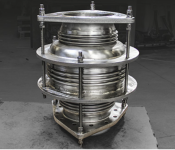Hello, experts,
I am designing a pump line for a high-pressure water supply system, and the pump has an expansion joint connected directly to its nozzle. The issue is that this pump provides an extremely low allowable nozzle load. The expansion joint is designed with tie-rods to resist thrust; however, due to thermal expansion issues with the piping, the inner nuts on the tie-rods need to be loosened. As a result, the thrust is no longer resisted by the tie-rods and instead enters the connected equipment nozzle — the pump — exceeding the allowable nozzle load.
I have heard from several other engineers that the actual net thrust acting on the pump nozzle should be evaluated as follows:
(Of course, the pump foundation (including anchor bolts) must resist the full thrust force.)
P = P1 - P2
P = Net thrust acting on the nozzle
P1 = Thrust generated due to the bellows' mean diameter
P2 = Thrust generated due to the pump nozzle’s internal diameter
I find this design approach reasonable and quite persuasive. However, I haven’t come across any design codes that support it.
Experts, is this approach correct? If so, is there a design standard available that could justify this approach to help persuade the client?
I would appreciate your opinions.
I am designing a pump line for a high-pressure water supply system, and the pump has an expansion joint connected directly to its nozzle. The issue is that this pump provides an extremely low allowable nozzle load. The expansion joint is designed with tie-rods to resist thrust; however, due to thermal expansion issues with the piping, the inner nuts on the tie-rods need to be loosened. As a result, the thrust is no longer resisted by the tie-rods and instead enters the connected equipment nozzle — the pump — exceeding the allowable nozzle load.
I have heard from several other engineers that the actual net thrust acting on the pump nozzle should be evaluated as follows:
(Of course, the pump foundation (including anchor bolts) must resist the full thrust force.)
P = P1 - P2
P = Net thrust acting on the nozzle
P1 = Thrust generated due to the bellows' mean diameter
P2 = Thrust generated due to the pump nozzle’s internal diameter
I find this design approach reasonable and quite persuasive. However, I haven’t come across any design codes that support it.
Experts, is this approach correct? If so, is there a design standard available that could justify this approach to help persuade the client?
I would appreciate your opinions.

